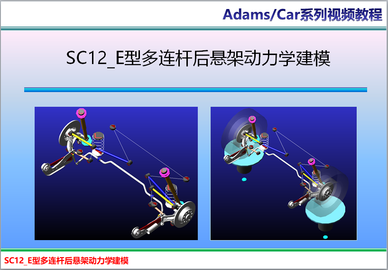Basic Course in Race Car Technology-“Bump Steer”
In racing, "bump steer" isunderstood to be the change in wheel steering angle or toe angle caused bywheel travel. For racing vehicles, the aim is often toachieve a small change in toe-in over the wheel travel. The influence ofthe suspension geometry on the "bump steer"behavior is shown by the examples outlined in Figs. 7.61, 7.62,7.63 and 7.64. In each case, a double wishbone axle with associated track rodis considered.

In the first case(Fig.7.61), it is a double wishbone suspension with equal length andparallel control arms. The track rod has the same length as the wishbones andis also arranged in parallel. In the side view, it can be seen that the jointson the wheel carrier side move on a circular path, the radius of whichcorresponds to the length of the control arm. Due to the parallel andequal-length arrangement, all wheel-side joint points move upward and inward bythe same amount. The wheel experiences no change in camber. In the top view, itcan be seen that the wheel carrier does not rotate due to the identicalmovement of the wheel-side wishbone bearings and the tie rod joint. The wheelsteering angle or toe-in angle remains unchanged during compression.

In the second example(Fig.7.62), the tierod is shortened and the pivot point on the wheel carrier is modifiedaccordingly. The result of this modification is that the track rod joint on thewheel carrier side now moves on a smaller circular radius. For the same springdeflection movement, this bearing point therefore covers a longer distanceinwards. The paths of the pivot points of the lower and upper wishbones remainunchanged. In the top view it can be seen that the wheel carrier is turned dueto the movement of the outer track rod joint. The toe-in of the wheel changesdue to the compression movement. In production passenger cars, this kinematicbehavior is deliberately used to optimize the vehicle's stability by increasingthe understeer tendency.
Inside front wheel turns in thedirection of toe-in
Curve outer front wheel turns in thedirection of toe-out
Inside rear wheel turns in thedirection of toe-out
Inside rear wheel turns in the directionof toe-in

A reduction in stability or understeer tendency results from a reversal of these kinematic and compliance directions of rotation.
Such behavior is often undesirable in racing vehicles. One reason for this is that one-sided deflection movements, such as those that occur when driving over curbs, lead to a disruptive change in the vehicle's course. Racing vehicles are more sensitive to such disturbances than production vehicles because of their high cornering stiffness and low yaw moments of inertia. A low degree of "bump steer” also has the advantage that a change in ground clearance, e.g. due to an adjustment of the setup or the increasing downforce with increasing driving speed, only has a minor effect on the wheel aligning values.
To completely avoid bump steer, three conditions must be met:
The virtual extension of the tie rod intersects the instantaneous center of the wheel carrier.
The inner tie rod joint lies on the connecting line of the inner wishbone bearings.
The outer tie rod joint lies on the connecting line of the outer wishbone bearings.
This generalized case is shown in Fig.7.64. It should be noted, however, that this statement is only sufficient forthe two-dimensional consideration of the geometry carried out here.















